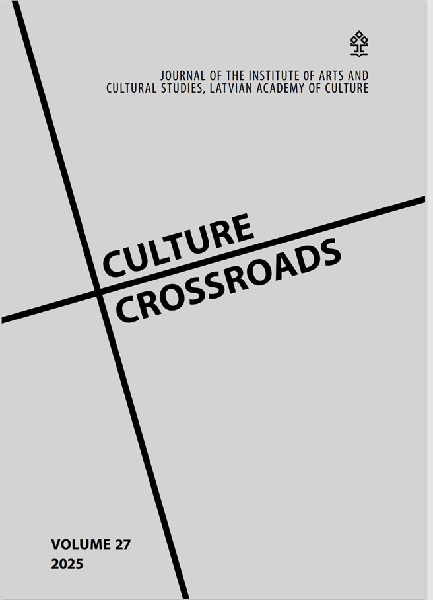AUTOBIOGRAPHICAL FAMILY NARRATIVES ABOUT HISTORICAL TRAUMA IN RECENT DOCUMENTARY CINEMA IN BALTIC COUNTRIES
DOI:
https://doi.org/10.55877/cc.vol27.537Keywords:
autobiographical narrative , first-person documentary, Estonian cinema, Latvian cinema, Lithuanian cinema, postmemory, mediated memory, historical traumaAbstract
Autobiography as a retrospective narrative authored by a real individual concerning its own existence in its literary form primarily focuses on the exploration of one’s personal life. Extending beyond literature into visual arts and performance, the autobiography has also found a strong expression in documentary filmmaking. These autobiographical narratives are conveyed through a diverse mix of audiovisual materials from both private and public archives, as well as with documentary animation techniques.
The article focuses on films from Estonia, Latvia and Lithuania, where personal memories of the filmmakers and their relatives form the foundation of the narrative about the deportations in the 1940s and Soviet occupation, presented in the first person from the perspective of the postmemory generation. The traumatic historical events of the 20th century in Estonia, Latvia and Lithuania hold particular significance for these filmmakers, and their films contribute to the broader body of work narrating the historical traumas of the region.
Downloads
References
Gyveno senelis ir bobutė / Grandpa and Grandma (2007). Directed by Giedrė Beinoriūtė. Lithuania: Monoklis.
Mans mīļākais karš / My Favorite War (2020). Directed by Ilze Burkovska-Jacobsen. Norway: Bivrost Film, Latvia: Ego Media.
Tõrjutud mälestused / Memories Denied (2005). Directed by Imbi Paju. Finland: Fantasiafilmi, Estonia: Allfilm.
Balčus, Z. (2021). Dokumentālais kino – studijas, autori, tēmas un stili. In: I. Pērkone, D. Rietuma, (eds.). Latvijas kinomāksla. Jaunie laiki. 1990–2020. Rīga: Dienas Grāmata, Latvijas Kultūras akadēmija, pp. 231–285.
Balčus, Z. (2021). Filmmakers as Onscreen Characters in Recent Latvian Documentary Cinema. Culture Crossroads, No. 18, pp. 55–65. https://doi.org/10.55877/cc.vol18.85
Brown, A. (2007) Seven Years that Changed the World: Perestroika in Perspective. Oxford: Oxford University Press.
Bruggeman-Sękowska, B. (2019). “How to become one person without double identities and lies to yourself.” Communications Unlimited. Available: https://www.communications- unlimited.nl/how-to-become-one-person-without-double-identities-and-lies-to- yourself/ (viewed 03.11.2024)
Brunow, D. (2015). Remediating transcultural memory: documentary filmmaking as archival intervention. Berlin; Boston: De Gruyter.
Bruss, E. (1980). Eye for I: Making and Unmaking Autobiography in Film. In: J. Olney, (ed.). Autobiography: Essays Theoretical and Critical. Princeton, New Jersey: Princeton University Press.
Christen, M. (2019). Media Studies. In: M. Wagner-Egelhaaf, (ed.). Handbook of Autobiography / Autofiction. Berlin; Boston: De Gruyter.
Cuevas, E. (2022). Filming History from Below: Microhistorical Documentaries. New York: Columbia University Press/ Wallflower.
Davoliūtė, V., Balkelis, T. (2012). Introduction. In: V. Davoliūtė, T. Balkelis, (eds.). Maps of Memory: Trauma, Identity and Exile in Deportation Memoirs from the Baltic States. Vilnius: Institute of Lithuanian Literature and Folklore.
Egan, S. (1994). Encounters in Camera: Autobiography as Interaction. Modern Fiction Studies, No. 40 (3), pp. 593–618.
Formenti, C. (2022). The Classical Animated Documentary and Its Contemporary Evolution. New York; London; Oxford; New Dehli; Sydney: Bloomsbury Academic.
Gabara, R. (2016). Mixing Impossible Genres: David Achkar and African Autobiographical Documentary (2003). In: J. Kahana, (ed.). Documentary Film Reader: History, Theory, Criticism. Oxford; New York: Oxford University Press.
Gūtmane, Z. (2019). Totalitārisma traumu izpausmes Baltijas prozā. Rīga: LU Literatūras, folkloras un mākslas institūts.
Hirsch, M. (2012). The Generation of Postmemory. Writing and Visual Culture after the Holocaust. New York: Columbia University Press.
Honess Roe, A. (2013). Animated Documentary. Basingstoke; New York: Palgrave Macmillan.
Kanopkaite, R.(2008). Moterisšiandieniniamelietuviųkine–ne papuošalas. Delfi, 19.11.2008. Available: https://www.delfi.lt/gyvenimas/istorijos/moteris-siandieniniame-lietuviu- kine-ne-papuosalas-19337972 (viewed 22.10.2024)
Kasekamp, A. (2018). A History of the Baltic States. 2nd ed. London: Palgrave Macmillan. Laanes, E. (2017). Trauma keelde tõlgitud. Kultuurideülesed mäluvormid eesti laagri-ja küüditamismälestustes. Keel ja Kirjandus, No. 4, pp. 241–257. https://doi.org/10.54013/kk713a1
Lane, J. (2002). The Autobiographical Documentary in America. Madison: The University of Wisconsin Press.
Lebow, A. (2008). First Person Jewish. Minneapolis: University of Minnesota Press.
Leese, P. (2022). The Limits of Trauma: Experience and Narrative in Europe c. 1945. In:
V. Kivimäki, P. Leese (eds.). Trauma, Experience and Narrative in Europe after World War II. Cham: Palgrave Macmillan.
Lejeune, P. (1989). On Autobiography. Minneapolis: University of Minnesota Press.
McDermott, K., Stibbe, M. (2010). Stalinist Terror in Eastern Europe: problems, perspectives, interpretations. In: K. McDermott, M. Stibbe, (eds.). Stalinist terror in Eastern Europe: Elite purges and mass repression. Manchester; New York: Manchester University Press.
Missine, L. (2019). Autobiographical Pact. In: M. Wagner-Egelhaaf, (ed.). Handbook of Autobiography / Autofiction. Berlin; Boston: De Gruyter.
Pērkone, I. (2023). Aizturēto asaru eposs. Dzintras Gekas esejas par genocīdu. Kino Raksti. Available: https://www.kinoraksti.lv/domas/latvijas-filma/aiztureto-asaru-eposs- dzintras-gekas-esejas-par-genocidu-1113 (viewed 14.02.2025)
Plakans, A. (2014). A Concise History of the Baltic States. Cambridge: Cambridge University Press.https://doi.org/10.1017/CBO9780511975370
Purs, A. (2010). Soviet in form, local in content: elite repression and mass terror in the Baltic states, 1940–1953. In: K. McDermott, M. Stibbe, (eds.). Stalinist terror in Eastern Europe: Elite purges and mass repression. Manchester; New York: Manchester University Press.
Renov, M. (2008). First-person Films. Some theses on self-inscription. In: T. Austin, W. de Jong (eds.). Rethinking Documentary. New Perspectives, New Practices. Maidenhead: Open University Press.
Šukaitytė, R. (2021). Contemporary Lithuanian Documentary Cinema: A Critical Overview of Main Film Directions. Apertúra, Fall, pp. 1–23. https://doi.org/10.31176/ apertura.2021.17.1.9
Šukaitytė, R. (2023). History in Lithuanian Women’s Creative Documentaries: Critical and Personal Approach. Panoptikum, No. 30, pp. 118–137. https://doi.org/10.26881/ pan.2023.30.07
Tuzaite, E. (2020). Kolektyvinė sovietmečio atmintis iš meno sociologijos perspektyvos: Giedrės Beinoriūtės ir Jūratės Kluonės atvejai. Filosofija. Sociologija. No. 31 (2), pp. 117–127. Available: https://www.lmaleidykla.lt/ojs/index.php/filosofija-sociologija/article/view/4230/3213 (viewed 22.10.2024)
Van Dijck, J. (2007). Mediated Memories in the Digital Age. Stanford, California: Stanford University Press.
Downloads
Published
Issue
Section
License
Copyright (c) 2025 Culture Crossroads

This work is licensed under a Creative Commons Attribution 4.0 International License.


